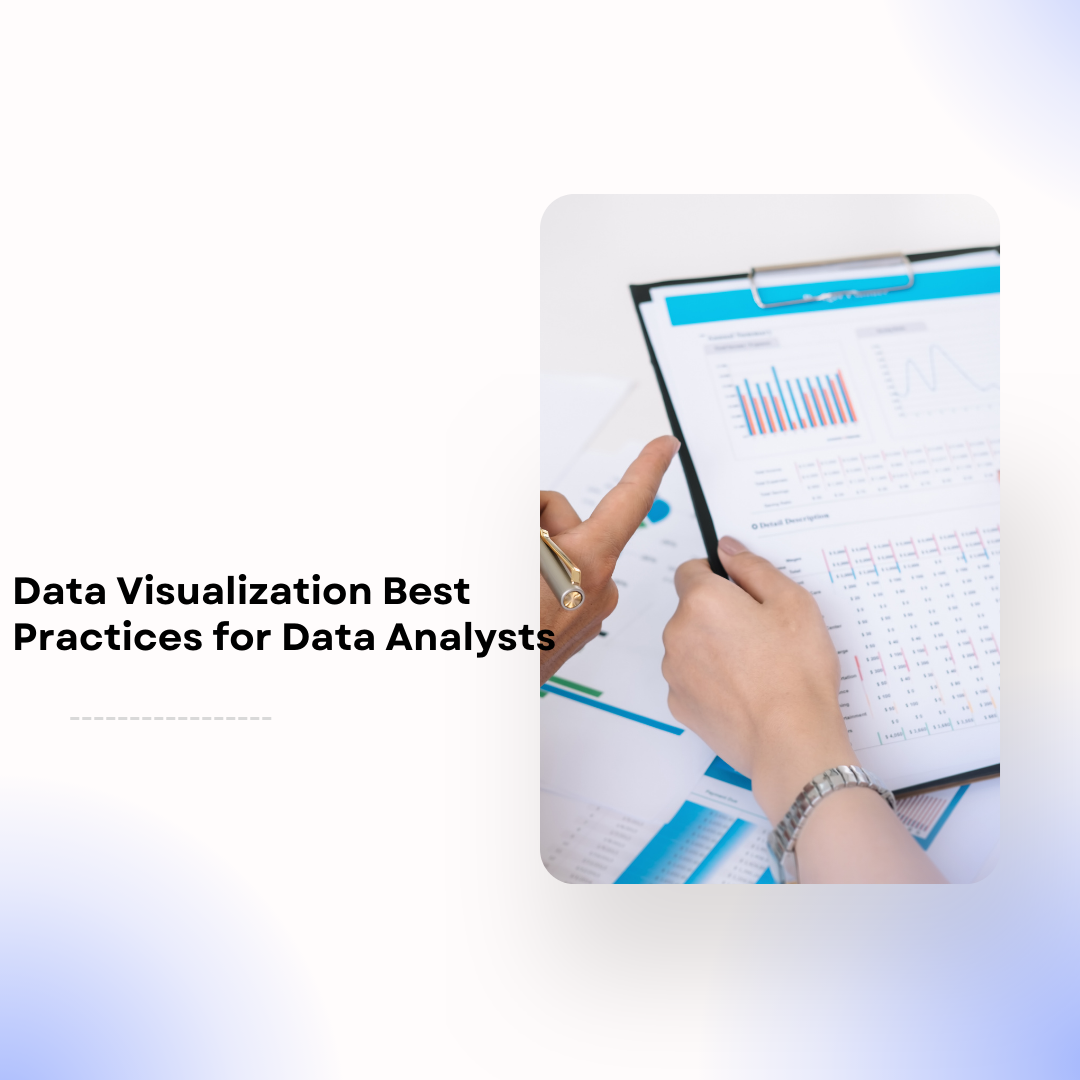Data Visualization Best Practices for Data Analysts
 Ruhi Parveen
Ruhi Parveen
Data visualization plays a critical role in helping data analysts present findings effectively. When done well, data visualization transforms complex datasets into clear, compelling visuals that inform decision-making and enhance understanding. Here are some best practices to follow in order to create impactful and accurate visualizations.
1. Understand Your Audience
Before you even begin creating a visualization, consider who will be viewing it. Different audiences have different levels of data literacy and different priorities. Tailoring your visuals to the audience ensures that your message is not only clear but also relevant.
Stakeholders and Executives: Focus on high-level insights and avoid overly complex data. Use summary metrics and visuals like bar charts, pie charts, or trend lines that quickly convey key points.
Technical Teams: Technical viewers may appreciate more detailed and intricate data representations, such as scatter plots, box plots, or heatmaps.
General Public: For a broader audience, simplify the visuals and focus on storytelling. Use straightforward charts and avoid jargon.
2. Choose the Right Chart Type
Selecting an appropriate chart type is crucial for accurate data representation. Different data types require different charts for optimal clarity.
Bar Charts: Ideal for comparing quantities across different categories.
Line Charts: Useful for showing trends over time.
Pie Charts: Best for displaying parts of a whole; avoid using too many categories.
Scatter Plots: Effective for showing relationships between two continuous variables.
Heatmaps: Good for showing intensity or density of data in a matrix format.
Always select a chart type that best represents the data's story, avoiding complex visuals that may confuse the viewer.
3. Simplify and Declutter
Simplicity is key in data visualization. Avoid unnecessary elements that don’t add value to your visual, as cluttered visuals can confuse the audience and detract from your main insights.
Minimize Colors and Fonts: Use a limited color palette and stick to a single font style for a clean look.
Remove Unnecessary Gridlines: Too many gridlines can distract the viewer; only keep essential lines.
Avoid 3D Effects: While 3D visuals may look impressive, they often distort data and make it harder to interpret accurately.
Keep only the essential elements that contribute to the understanding of the data.
4. Use Color Purposefully
Color can enhance the readability of your visualizations, but it should be used carefully. Improper use of color can mislead or overwhelm your audience.
Consistent Color Scheme: Use a cohesive color scheme across your visuals to create a unified look.
Highlight Important Data: Use contrasting colors to emphasize critical points or trends.
Consider Colorblind-Friendly Palettes: Many people are colorblind, so avoid red-green combinations and consider using colorblind-friendly palettes.
Limit the Number of Colors: Too many colors can confuse viewers. Aim to use no more than five colors in a single chart unless necessary.
5. Label Your Data Clearly
Proper labeling is essential for effective data visualization. Labels should provide the viewer with enough context to understand the data without overwhelming them.
Axis Labels: Always include labels on both the x-axis and y-axis to explain what each dimension represents.
Data Labels: For specific values, add data labels directly on the visual when needed, especially if the audience may need precise numbers.
Title and Subtitle: Use descriptive titles and subtitles to set the context. This helps the viewer quickly grasp the purpose of the chart.
Legends: Only include a legend if it’s necessary to differentiate elements in the chart.
Clear labeling makes it easier for viewers to interpret your visualization accurately.
6. Provide Context with Annotations
Annotations help add clarity by providing additional context or explanations within the visualization. This is especially useful when highlighting trends, anomalies, or significant events in the data.
Highlight Key Points: Use annotations to draw attention to critical data points, such as a peak or drop.
Add Explanations: Short text boxes can explain patterns, changes, or outliers.
Use Arrows or Circles: Simple shapes like arrows or circles can direct the viewer’s focus to areas of interest.
Annotations should be brief and to the point, adding context without overwhelming the viewer.
7. Maintain Data Accuracy
Ensuring that your visualization is an accurate representation of the data is essential. Misleading visualizations can lead to incorrect conclusions and poor decision-making.
Use Consistent Scales: Avoid manipulating axes to exaggerate trends. Keep your scales consistent across related charts for comparability.
Avoid Data Distortion: Be cautious with chart types that can distort data, like pie charts with too many slices or truncated bar charts.
Check for Outliers and Errors: Ensure that any outliers are handled properly and that there are no errors in the dataset.
Provide Reference Points: When appropriate, include benchmarks or averages to give viewers a point of comparison.
A clear and accurate visualization builds trust and helps convey the true insights within your data.
8. Use Interactive Features Wisely
Interactive visualizations can enhance engagement and allow users to explore data in more detail. However, they should be used carefully, as too much interactivity can make a visual overwhelming or difficult to use.
Drill-Down Options: Allow users to click on elements to see more detailed information if your data has multiple layers.
Hover Tooltips: Tooltips that appear on hover can display specific values without cluttering the visual.
Filters and Selectors: Interactive filters let users focus on particular segments of data relevant to them.
Responsiveness: Ensure your visualizations are optimized for various devices, including mobile and desktop.
Choose interactivity that genuinely enhances understanding without sacrificing clarity.
9. Tell a Story with Your Data
Effective data visualization goes beyond charts and graphs. It involves telling a story that guides the audience through the data.
Start with an Insightful Question: Frame your visualization with a central question or hypothesis to give it direction.
Organize the Flow: Arrange your visualizations logically, often following a cause-effect or chronological sequence.
Provide Key Takeaways: Summarize the most important points from your data at the end.
Use a Narrative: Add brief narrative elements to guide the viewer through your insights and conclusions.
Storytelling makes data more relatable and memorable for the audience.
10. Test Your Visualizations
Testing your visualizations before presenting them can reveal potential issues and improve clarity.
Get Feedback: Show your visualizations to a colleague or a small sample of your audience to get feedback on readability and interpretation.
Check for Accessibility: Ensure that your visuals are accessible to people with disabilities, including those with color vision deficiencies.
Optimize Load Time: For web-based visuals, test load times to ensure quick access and smooth functionality.
Refine Based on Feedback: Use any feedback to refine and improve your visuals before sharing them with a broader audience.
Testing helps ensure that your visualizations are accurate, accessible, and effective.
11. Continuously Improve Your Skills
Data visualization is a field that evolves with technology and techniques. Keeping up-to-date with new tools, trends, and best practices is essential for data analysts.
Learn New Tools: Explore software like Tableau, Power BI, or D3.js for advanced visualizations.
Stay Updated on Trends: Read articles and case studies on effective data visualization strategies.
Practice and Experiment: Regularly create new visualizations and experiment with different types of data to refine your skills.
Seek Feedback and Mentorship: Joining a data visualization community or finding a mentor can provide valuable insights for growth.
Continuous improvement keeps your skills sharp and your visualizations impactful.
Conclusion
Data visualization is an art as much as it is a science. Following these best practices will help you create visuals that are not only aesthetically pleasing but also accurate, accessible, and informative. By understanding your audience, selecting appropriate chart types, simplifying visuals, and ensuring data accuracy, you can effectively communicate complex data insights and support informed decision-making. For those pursuing a Data Analytics Certification Course in Noida, Delhi, Mumbai, Pune, Goa, and other parts of India, mastering these visualization techniques is essential to becoming proficient in data-driven storytelling.
Subscribe to my newsletter
Read articles from Ruhi Parveen directly inside your inbox. Subscribe to the newsletter, and don't miss out.
Written by

Ruhi Parveen
Ruhi Parveen
I am a Digital Marketer and Content Marketing Specialist, I enjoy technical and non-technical writing. I enjoy learning something new.